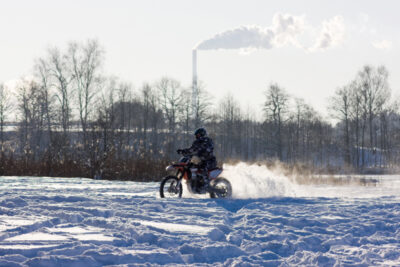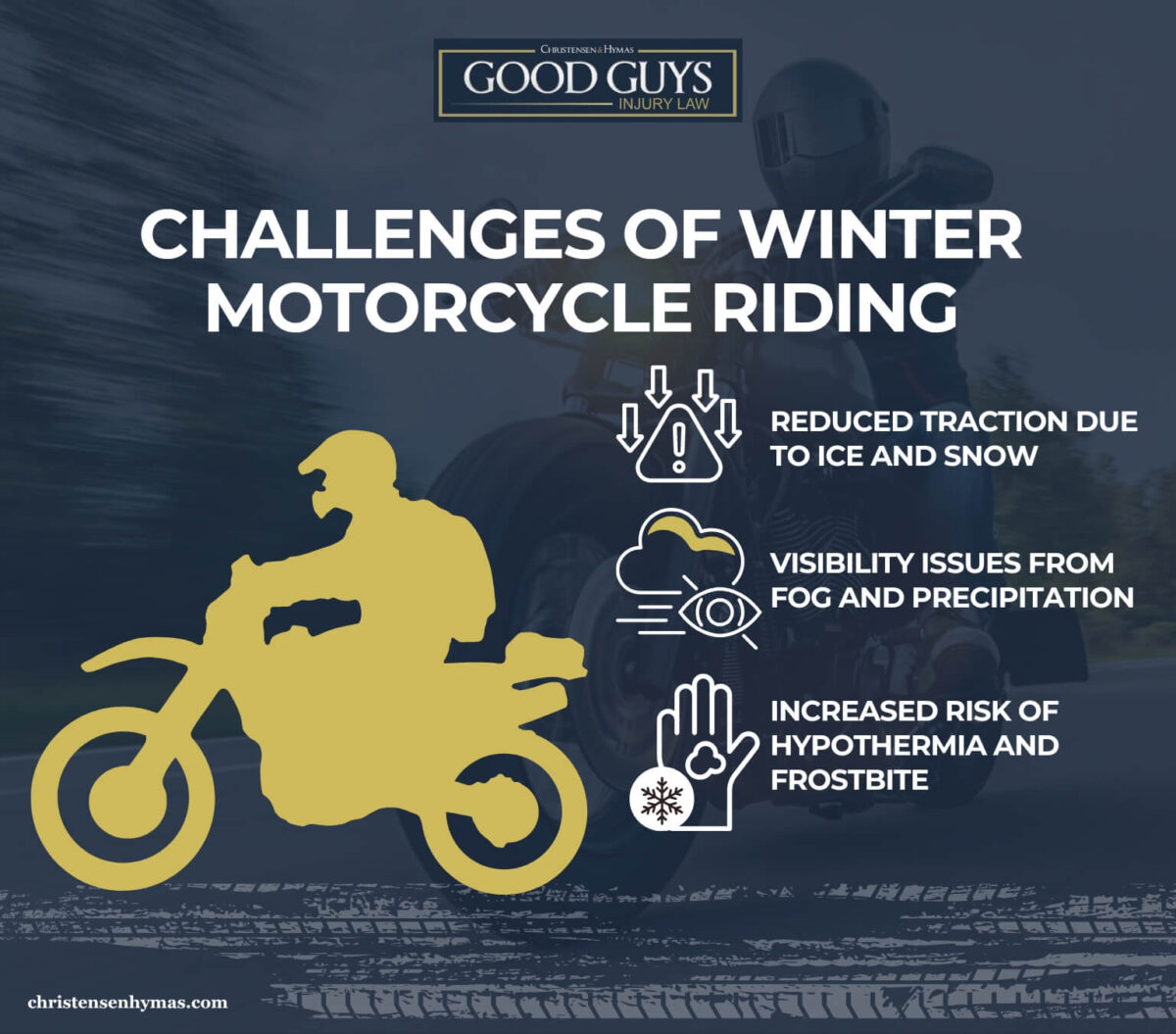
Riding on icy roads and freezing winds tests even the most experienced motorcyclists. As temperature drops, surfaces become slippery, and controlling your bike grows more difficult. Even skilled riders struggle when weather conditions change quickly, so careful preparation is essential. At Good Guys Injury Law, we know that winter conditions make riding a motorcycle an extreme challenge.
Some riders embrace the winter motorcycle experience because it offers quieter roads and a unique challenge. However, cold air can affect your comfort and your bike’s performance.
With the right approach, proper gear (like a neck warmer), and an awareness of your limits, you can ride more safely, even in tough conditions.
Learn more about riding a motorcycle in the winter below. Then, contact us to schedule a free case review.

If you've been involved in a motorcycle accident, don't wait to get the help you need. Good Guys Injury Law is ready to fight for you.
Table of Contents
Challenges of Winter Motorcycle Riding

Winter riding demands extra care because snow, ice, and slush introduce serious hazards. You must use caution, adjust your technique, and always stay alert. Before discussing managing these issues, let’s explore your main dangers. A few key challenges during the winter riding season include:
Reduced Traction Due to Ice and Snow
A key concern in cold-weather riding is the reduced grip caused by ice and snow. Bikes can lose traction much more easily on frozen surfaces, making sudden maneuvers risky. Cold tires often harden, further decreasing their ability to grip the road.
Under these conditions, ride slower, keep a greater following distance, and make all movements as smooth as possible.
Visibility Issues From Fog and Precipitation
Winter weather can bring fog, sleet, or heavy snowfall that clouds your view. Limited visibility hides obstacles, other vehicles, and sudden changes in traffic flow.
Use proper lighting, keep your visor clean, and consider reflective gear to counteract this. Adjusting your speed and leaving more room between yourself and others can help you handle these visual challenges.
Increased Risk of Hypothermia and Frostbite
Exposure to cold weather means you can lose body heat faster than expected. Without proper winter gear, frigid temperatures numb your hands, feet, and face. Extended rides in these conditions make staying warm and maintaining focus hard.
Recognize the signs of frostbite and hypothermia, and protect yourself from serious health risks. Consider getting long underwear that you can wear underneath your motorcycle gear for extra warmth.
Tips for Riding Safely in Winter

Cold-weather riding feels challenging, but you can take steps to make winter riding safer. These actions can improve your comfort, reduce motorcycle accidents, and help you maintain control. A few key tips to keep in mind include:
- Dress in layers. Multiple layers trap body heat and let you adjust if it gets warmer or cooler. Consider adding heated gear to hold in as much heat as possible.
- Use proper winter riding gear. A waterproof jacket and pants keep you dry in wet weather. High-quality gloves and boots protect against frostbite and improve comfort. This gear can also reduce your chances of suffering serious injuries.
- Check your tires. Switch to winter tires for better traction in icy conditions. Monitor tire pressure frequently, as cold temperatures can lower it, reducing grip. Consider consulting an expert who can help you find the best winter tires.
- Stay visible. Reflective clothing and good lighting help others see you. Clean lights and your visor often to ensure maximum clarity.
- Watch for road salt. Salt improves traction on icy roads but can corrode your bike. Rinse your motorcycle regularly to prevent buildup and preserve handling.
Following these tips requires extra effort, but the payoff includes safer, more stable rides. While you cannot eliminate all risks, you can greatly reduce them.
Preparing Your Motorcycle for Winter
Your bike must handle the tougher conditions that come with cold months. Some upgrades and maintenance steps keep it running smoothly and reliably. A few key upgrades to consider for the winter months include:
- Inspect your brakes. Check pads and rotors for wear. Strong braking power becomes even more critical on slick surfaces.
- Upgrade your fluids. Use oil and coolant formulated for lower temperatures. These choices help your engine run smoothly despite the cold.
- Maintain your battery. Cold conditions drain battery power more quickly. Keep it charged, and consider storing it in a warmer spot if possible.
- Clean and lubricate moving parts. Dirt and debris can freeze and affect performance. Regular cleaning prevents costly, long-term damage.
- Adjust suspension settings. Fine-tuning your suspension improves handling on uneven winter roads. Better control makes every ride safer and more comfortable.
Investing time in these preparations saves money, improves stability, and reduces frustration. A well-maintained bike also helps you tackle winter challenges with greater confidence.
When to Avoid Riding

No matter your skill, some situations prove too dangerous for a winter ride. Recognizing when conditions exceed your comfort level protects you from serious trouble. A few warning signs that suggest you should leave your bike parked include:
Hazardous Weather Conditions to Watch For
Severe storms, freezing rain, and heavy snowfall create risks you cannot ignore. Strong winds can push your bike off course, and thick snow reduces visibility. Even mild precipitation can make roads slick and unpredictable. If you see thick ice, heavy snow, or extremely low temperatures, consider waiting until things improve.
According to the Utah Department of Transportation (UDOT), road crews work hard to make winter roads safer by spreading materials like salt or sand, but riders must still remain cautious. Traction may improve when plows spread materials like salt or sand, but bumps and uneven surfaces appear.
Keep an eye on changing conditions, and choose routes wisely. Staying informed allows you to judge when riding makes sense and when it doesn’t.
Knowing When to Use Alternative Transportation
Using a car, bus, or train sometimes beats riding in extreme cold or dangerous weather. If the forecast calls for freezing rain, deep snow, or brutal winds, consider leaving your bike at home.
This choice lowers your chance of an accident and protects your health. Accepting a day or two without riding can prevent serious problems later on.
Risks of Black Ice and Severe Cold
Black ice forms a thin, nearly invisible layer on the road’s surface. You cannot easily spot it, so even careful riders may slip and fall unexpectedly.
Hitting black ice can throw you off your bike and cause serious harm. The severe cold accompanying these conditions adds another layer of danger, making safe travel almost impossible.
Controlling your bike becomes extremely tough when black ice and freezing temperatures combine. Your odds of a crash rise sharply if you attempt to press on. No gear or skill guarantees safety on hidden ice patches. Sometimes, waiting it out and choosing a better time to ride proves smarter.
How Our Utah Motorcycle Accident Lawyer Can Help You After a Winter Crash
If a winter crash happens, you deserve help to know your rights and to recover from your losses. A Utah motorcycle accident lawyer provides valuable guidance and ensures you receive the support you need to recover. A few ways we can help you include:
- Legal guidance. A personal injury attorney outlines your options and explains each step in the process. Knowledge of the law helps you avoid mistakes.
- Thorough investigation. The attorney reviews evidence, consults experts, and gathers facts. A solid investigation strengthens your personal injury claim.
- Negotiating with insurance companies. Dealing with an insurance company alone can lead to poor results. Your lawyer pushes for fair compensation so you do not settle for too little.
- Handling all paperwork. Filing documents and managing details requires time and skill. A personal injury lawyer takes care of these tasks so you can focus on healing.
- Representation in court. If negotiations fail, your attorney can present your personal injury case before a judge and jury. Skilled advocacy often leads to better outcomes.
You can work through the personal injury process more easily with the right support. Do not face these challenges alone when help is available.


Contact Good Guys Injury Law for Your Free Personal Injury Case Consultation
Contact Our Utah Motorcycle Accident Attorney for a Free Case Consultation

You deserve clear answers and support after a winter crash. At Good Guys Injury Law, our Utah motorcycle accident attorney offers a free case consultation to review your situation and explain your options.
We stand by our clients, providing honest guidance and dedicated representation. Contact us today, and let us help you move forward after a difficult event.






